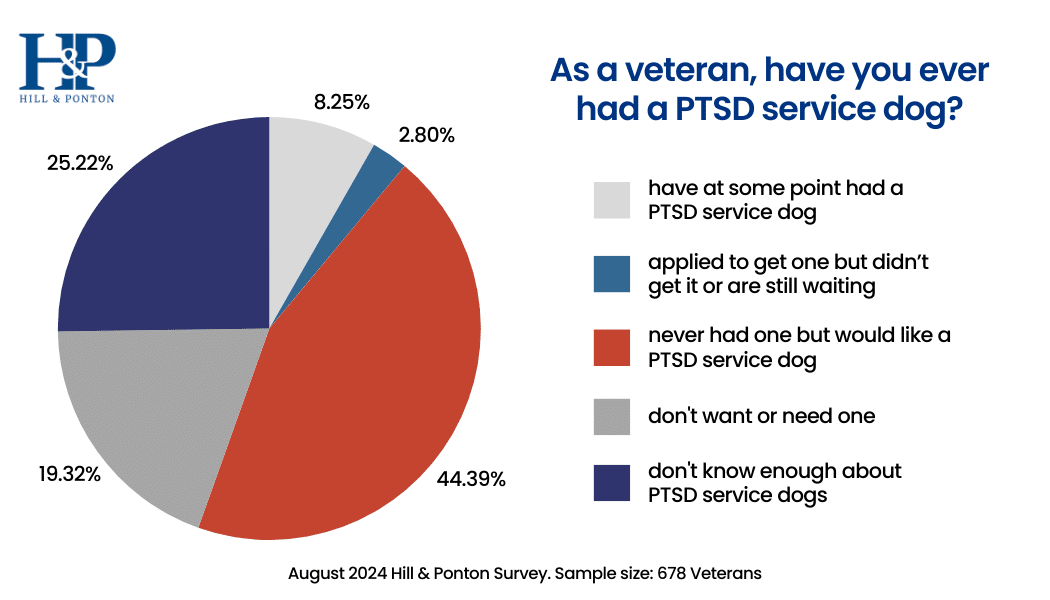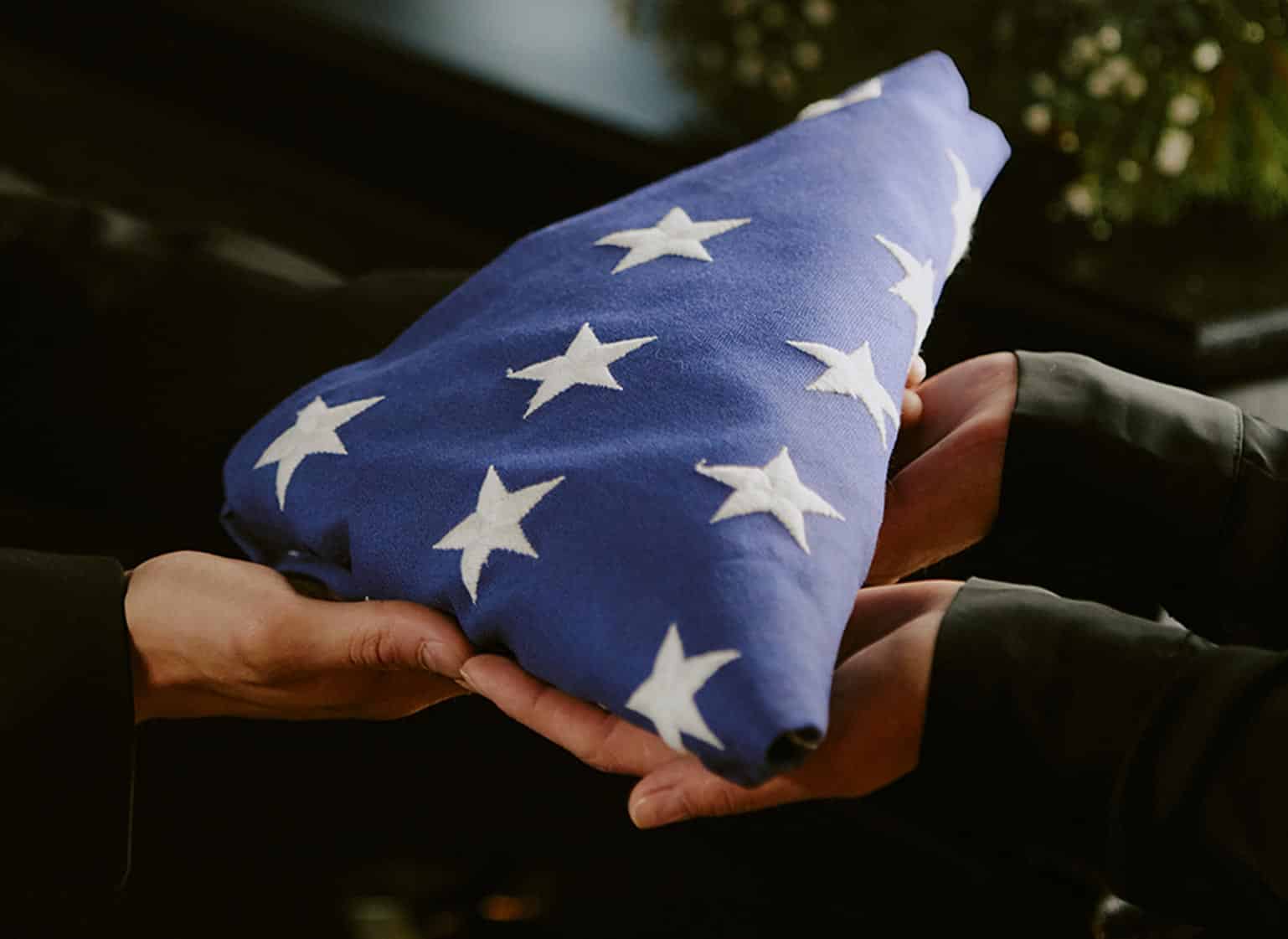While service dogs have traditionally been provided to assist veterans with physical disabilities, there has been a growing interest in using service dogs to improve the quality of life of veterans suffering from mental health disorders. This article will explore some of the most recent research on the impact of service dogs in the treatment of PTSD.
An Emerging Complementary Treatment
Although PTSD awareness and treatments greatly improved in recent decades, U.S. military personnel have been encountering unprecedented stressors, resulting in an elevated risk of developing PTSD. Soldiers who served in Operations Iraqi Freedom (OIF) and Enduring Freedom (OEF) were exposed to the constant threat of improvised explosive devices (IEDs) and the strain of multiple deployments. These warfare conditions have contributed to PTSD cases that are often more severe than those observed following the Vietnam War.
29% of Iraqi Freedom and Enduring Freedom veterans develop PTSD.
2024
U.S. Department of Veterans Affairs
A 2015 meta-analysis of the studies involving OEF/OIF veterans estimated that approximately 23% of veterans who served in Iraq and Afghanistan had PTSD [1]. The current estimate recognized by the U.S. Department of Veterans Affairs (VA) is a 29% PTSD rate for the veterans who participated in the operations Iraqi Freedom and Enduring Freedom. Consequently, the demand for effective PTSD treatments for veterans has remained high, possibly surpassing that of any previous era in U.S. military history.
VA has been providing a range of psychotherapies for PTSD treatment that can be broadly classified into two categories: trauma-focused and non-trauma-focused therapies. Trauma-focused therapies directly address traumatic experiences, requiring patients to actively engage with trauma-related memories, beliefs, and triggers. These therapies utilize various strategies, including behavioral, cognitive-behavioral, and emotion-focused approaches. In contrast, non-trauma-focused therapies avoid direct engagement with traumatic events, instead concentrating on building support, empathy, insight, and adaptive coping mechanisms.
Research has consistently demonstrated that trauma-focused therapies are significantly more effective. Therefore, VA primarily offers two trauma-focused psychotherapies: Prolonged Exposure (PE) and Cognitive Processing Therapy (CPT). These treatments have a remarkable efficacy in reducing PTSD symptoms and have benefited many veterans. However, their effectiveness hinges on the patient’s consistent and active participation over an extended period, often involving emotionally and practically demanding tasks. Such high level of commitment poses a persistent challenge for many veterans engaging in PE and CPT. [2]
Analysis of recent studies has shown that trauma-focused treatments have an average dropout rate of 27.1% among enlisted service members [3]. This could be even higher in uncontrolled conditions. Maguen et al.’s (2019) research of a single Veteran’s Health Administration facility under typical conditions, spanning from October 2001 to September 2015, found that only 22.8% of veterans initiated evidence-based psychotherapies like PE or CPT [4]. More concerningly, a mere 9.1% of this group completed the treatment, translating to an attrition rate exceeding 60%.
Recent research has explored the potential of non-trauma focused interventions that encourage patient engagement and retention while addressing PTSD symptoms. One promising adjunct intervention is the use of specially trained psychiatric service dogs. These dogs are distinct from emotional support, therapy, or companion animals in that they are specifically trained to perform tasks tailored to the psychiatric needs of their handlers, such as interrupting anxiety episodes, waking them from nightmares, or providing a buffer in crowded public settings.
Note: VA does not currently provide or support service dogs for mental health conditions, including PTSD, and is still studying the potential benefits of such interventions.
Veterans’ Voices: Interest in PTSD Service Dogs
In August 2024, Hill & Ponton polled its audience to gauge the level of interest and access to PTSD service dogs. The 678 veterans who answered provide a snapshot of the current landscape regarding PTSD service dogs:
- 8.25% have at some point had a PTSD service dog
- 2.80% applied to get one but didn’t get it or are still waiting
- 44.39% never had one but would like a PTSD service dog
- 19.32% don’t want or need one
- 25.22% don’t know enough about PTSD service dogs
The answers suggest that there is significant interest among veterans for PTSD service dogs, coupled with a lack of access. Moreover, a quarter of those polled lacked information about this type of treatment.

Comments received from Veterans include:
A private psychologist did testing to support my PTSD claim and recommended that I get a service dog to help me deal with PTSD issues. Archie has been my angel service dog, and truly helps me daily living with PTSD and migraines.
A social worker said a service dog would benefit me but that was a couple years ago, and nothing has been said to me since then.
My personal dog goes everywhere possible with me and can tell when I’m getting uncomfortable. He will get on my lap, paw at me, get my attention. I would love to get him trained and certified to travel with me more places. Would love to get more info on the subject.
I don’t know how to even begin to seek receiving a service dog.
I attended several nonprofit organizations that provide PTSD Service dogs to veterans without success as the dogs were not properly trained. I purchased my own puppy and paid to acquire great training from a for profit organization. My dog is now trained for mobility, PTSD, scent detection, tracking and personal security. She is better than any dog I could get from a non profit for PTSD. Alot of it is because I put skin in the game and was totally committed. I am training another puppy for when my current service dog retires.
Recent Research Shows the Benefits of PTSD Service Dogs
Multiple studies utilizing the PTSD Checklist (PCL), a standardized self-report scale, have found that being partnered with a service dog is associated with significantly lower PTSD symptom severity compared to not having a service dog.
Rodriguez et al. (2018) compared 45 veterans with service dogs to 28 on a waitlist and found those with dogs scored significantly lower on the PCL. [5]
Most recently, Leighton et al. 2024 nonrandomized controlled trial of 156 veterans and military members [6], which is the largest nationwide study to date to compare the use of PTSD service dogs with usual care alone, measured PTSD symptoms after 3 months, with the following results:
The PCL-5 test
- Service dog group average score: 41.9
- Control group average score: 51.7
The CAPS-5 test
- Service dog group average score: 30.2
- Control group average score: 36.9
The service dog group’s lower scores represent significantly lower PTSD symptom severity. The researchers also looked at how many people still met the criteria for PTSD after 3 months:
- In the service dog group, 75% (51 people) still had PTSD
- In the control group, 85% (56 people) still had PTSD
Beyond subjective self-report measures, biological markers also point to the therapeutic effects of service dogs. Rodriguez et al. (2018) examined the cortisol awakening response (CAR) in veterans with and without service dogs. The study found that veterans with service dogs had a bigger morning spike in cortisol compared to those without, which would indicate a healthier response to stress. This biological evidence supports the notion that service dogs may help restore balance to veterans’ stress response systems.
In 2024 a 3 month clinical trial drew similar conclusions, suggesting that service dog placement could help boost veterans’ morning cortisol response. [7]
These consistent findings across multiple studies provide strong evidence for the efficacy of service dogs in reducing PTSD symptom severity among veterans.
PTSD Service Dogs vs. Emotional Support Dogs
The Richerson et al. (2023) study, titled “Therapeutic and Economic Benefits of Service Dogs Versus Emotional Support Dogs for Veterans With PTSD,” [8] is one of the most comprehensive investigations to date. The researchers conducted a multicenter trial with 227 veterans with PTSD over 18 months, randomly assigning them to receive either a service dog or an emotional support dog.
Results:
PTSD Symptoms: Participants with service dogs had a 3.7-point greater reduction in PTSD symptoms compared to those with emotional support dogs.
Medication Adherence: Veterans with service dogs had an increase of 10 percentage points in antidepressant adherence compared with those with emotional support dogs.
This study provides strong evidence for the specific benefits of service dogs over emotional support dogs in reducing PTSD symptoms and improving medication adherence.
Specific Tasks Performed by Service Dogs
To understand how service dogs alleviate PTSD symptoms, Rodriguez et al. (2020) surveyed a group of veterans’ perceived importance of the trained tasks performed by service dogs:
- Interrupt/alert – The dog lets the veteran know when they are feeling anxious and interrupts with a nose bump, placing head in lap, or some other behavior.
- Calm/comfort anxiety – The dog performs a calming behavior such as making physical contact (laying on top of handler, placing head in lap, gently leaning against the body) when the veteran feels distress or anxiety.
- Block (create space) – The dog positions itself horizontally in front of the veteran to create personal space.
- Block (guard/protect) – The dog positions itself horizontally in front of veteran to guard/protect.
- Cover (watch back) – Dog positions itself directly behind the veteran to “watch” the veteran’s back.
- Social greeting – The dog helps greet people in public by sitting/offering a paw.
- Wake up from nightmare – The dog recognizes that the veteran is having a nightmare and gently wakes them up.
The study found that the task most frequently performed by service dogs was to calm/comfort anxiety, reported in 52% of daily check-ins. [9] The “cover” or “watch my back” task was the second most frequently used, averaging 4.1 times daily. This task mimics military camaraderie, where soldiers guard each other’s blind spots in combat. Veterans report that this helps them share the burden of being constantly alert in public.
The social greeting task, while less broadly applicable to PTSD symptoms, was still considered moderately important. It’s especially useful in public interactions and may contribute to reduced social isolation and increased participation observed in veterans with service dogs.
The nightmare wake-up task specifically targets intrusive memories, nightmares, and sleep disturbances. 57% of veterans found this helpful for trauma-related nightmares, making it a crucial aspect of the service dog intervention for many.
The two versions of the “block” task – creating personal space and guarding/protecting – were rated similarly by veterans. While some mental health professionals worry this task might reinforce avoidance behaviors, veterans found it moderately to quite important for their PTSD.
Overall, service dog tasks addressed almost every DSM-5 PTSD symptom, with intrusion symptoms benefiting from the most tasks, particularly calm/comfort and interrupt/alert. The dogs’ calming presence and interrupting behaviors appear to help ground veterans during flashbacks and provide relief from distress.
In Veterans’ Own Words
The most helpful thing the dog does for one veteran is to “be able to walk through life knowing that if I were to have an anxiety attack it wouldn’t be the end of the world, I would have my battle buddy [service dog] to get through it.” [10]
For others, a service dog:
- “reminds me to take my medication because he senses my mood and work [quality] deteriorates if I don’t take my medication. “
- “gets me motivated, to get up and get outside” [11]
- “[gives] constant companionship, I know he is always by my side. We are always together.”
- “sleeps with me and wakes me up from nightmares”
- “has allowed me to go to crowded public places to support my children’s activities that I previously would not have gone to”
- “blocks people from getting too close and forces me to focus on her when I have rage episodes”
- “has allowed me to become the father and husband I am supposed to be”
- “has definitely improved my life in so many ways and has given me a better outlook overall” [10]
For these veterans, service dogs are more than just a treatment option. Their unconditional love and devoted companionship sets service dogs apart from other interventions and enables profound transformation of veterans’ lives.
Conclusion
The use of service dogs for veterans with PTSD shows promise as a complementary intervention. Current evidence suggests that service dogs can contribute to reduced PTSD symptoms and enhanced social functioning for many veterans. The high level of interest in PTSD service dogs among veterans underscores the need for continued research, education, and support.
References
- Fulton, J.J.; Calhoun, P.S.; Wagner, H.R.; Schry, A.R.; Hair, L.P.; Feeling, N.; Elbogen, E.; Beckham, J.C. The prevalence of posttraumatic stress disorder in Operation Enduring Freedom/Operation Iraqi Freedom (OEF/OIF) veterans: A meta-analysis. J. Anxiety Disord. 2015, 31, 98–107. https://www.sciencedirect.com/science/article/abs/pii/S0887618515000262
- Lee, A.J.; LaFreniere, L.S. Addressing Attrition from Psychotherapy for PTSD in the U.S. Department of Veterans Affairs. Trauma Care 2023, 3, 274-293 https://www.mdpi.com/2673-866X/3/4/24
- Edwards-Stewart, A.; Smolenski, D.J.; Bush, N.E.; Cyr, B.-A.; Beech, E.H.; Skopp, N.A.; Belsher, B.E. Posttraumatic stress disorder treatment dropout among military and veteran populations: A systematic review and meta-analysis. J. Trauma. Stress 2021, 34, 808–818. https://pubmed.ncbi.nlm.nih.gov/33524199/
- Maguen, S.; Li, Y.; Madden, E.; Seal, K.H.; Neylan, T.C.; Patterson, O.V.; DuVall, S.L.; Lujan, C.; Shiner, B. Factors associated with completing evidence-based psychotherapy for PTSD among veterans in a national healthcare system. Psychiatry Res. 2019, 274, 112–128. https://pubmed.ncbi.nlm.nih.gov/30784780/
- O’Haire, M. E. & Rodriguez, K. E. Preliminary efficacy of service dogs as a complementary treatment for posttraumatic stress disorder in military members and veterans. J. Consult. Clin. Psychol. 86, 179–188 (2018). https://pubmed.ncbi.nlm.nih.gov/29369663/
- Leighton SC, Rodriguez KE, Jensen CL, et al. Service Dogs for Veterans and Military Members With Posttraumatic Stress Disorder: A Nonrandomized Controlled Trial. JAMA Netw Open. 2024;7(6):e2414686 https://jamanetwork.com/journals/jamanetworkopen/fullarticle/2819452
- Nieforth LO, Rodriguez KE, Zhuang R, et al. The cortisol awakening response in a 3 month clinical trial of service dogs for veterans with posttraumatic stress disorder. Sci Rep. 2024;14(1):1664 https://pubmed.ncbi.nlm.nih.gov/38238350/
- Richerson JT, Wagner TH, Abrams T, et al. Therapeutic and economic benefits of service dogs versus emotional support dogs for veterans with PTSD. Psychiatr Serv. 2023;74(8):790-800 https://pubmed.ncbi.nlm.nih.gov/36718602/
- Rodriguez KE, LaFollette MR, Hediger K, Ogata N, O’Haire ME. Defining the PTSD Service Dog Intervention: Perceived Importance, Usage, and Symptom Specificity of Psychiatric Service Dogs for Military Veterans. Front Psychol. 2020 Jul 21;11:1638. https://pubmed.ncbi.nlm.nih.gov/32849004/
- Nieforth LO, Rodriguez KE, O’Haire ME. Expectations versus experiences of veterans with posttraumatic stress disorder (PTSD) service dogs: An inductive conventional content analysis. Psychol Trauma. 2022 Mar;14(3):347-356 https://pubmed.ncbi.nlm.nih.gov/33630635/
- Crowe, T. K., Nguyen, M. T., Tryon, B. G., Barger, S., & Sanchez, V. (2018). How Service Dogs Enhance Veterans’ Occupational Performance in the Home: A Qualitative Perspective. The Open Journal of Occupational Therapy, 6(3). https://scholarworks.wmich.edu/ojot/vol6/iss3/12/




